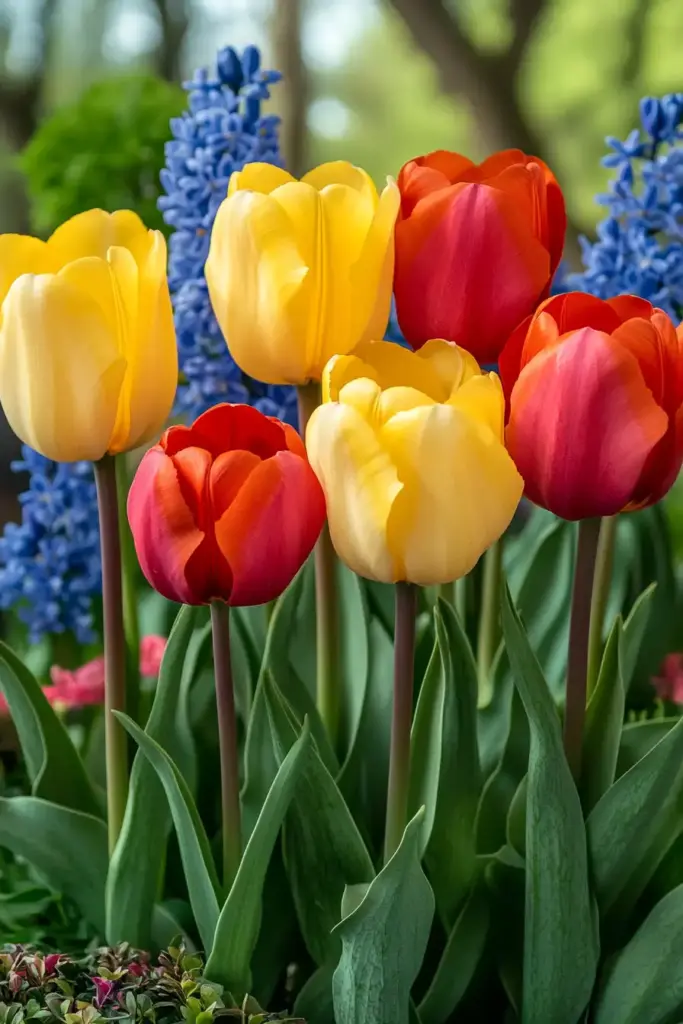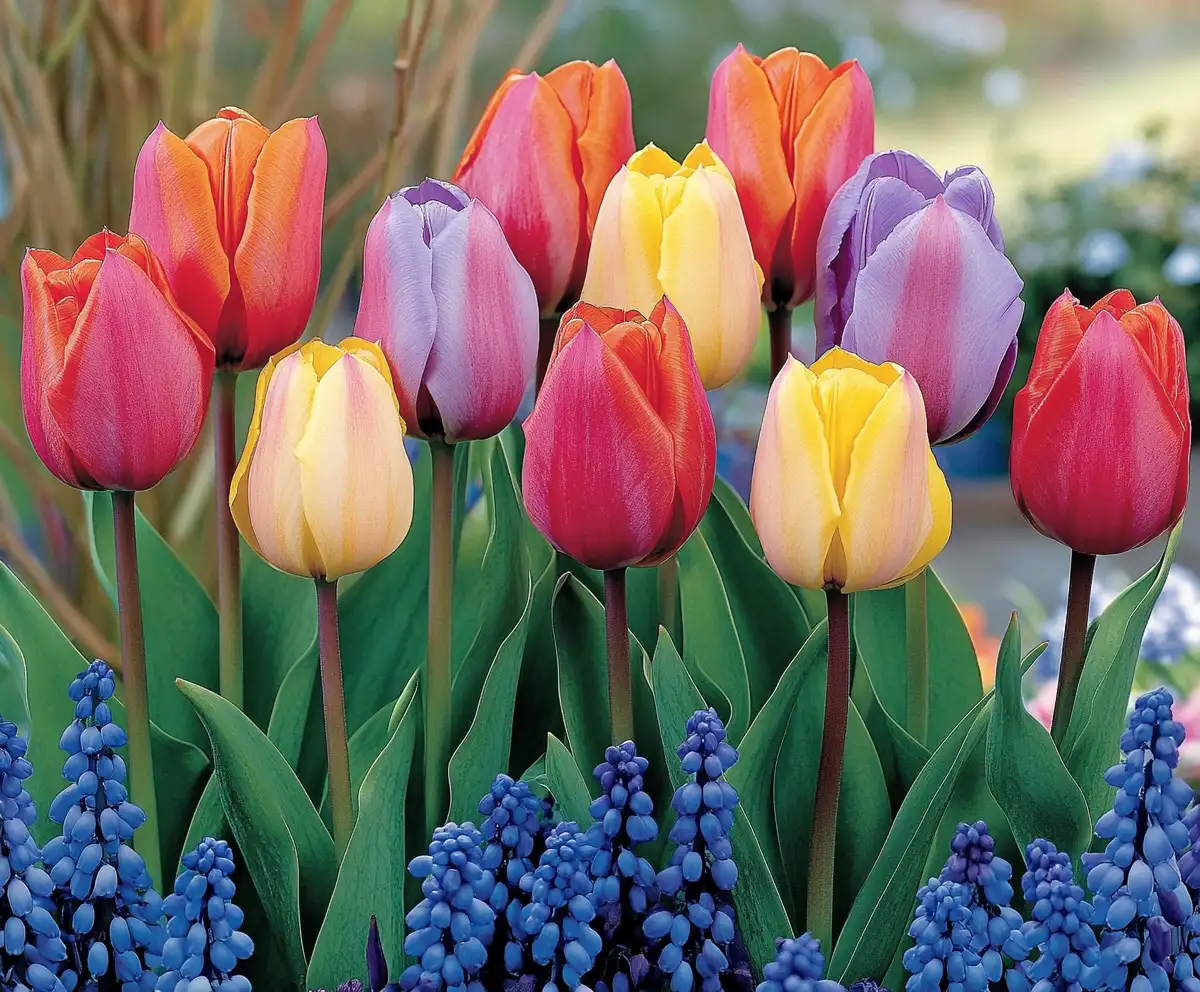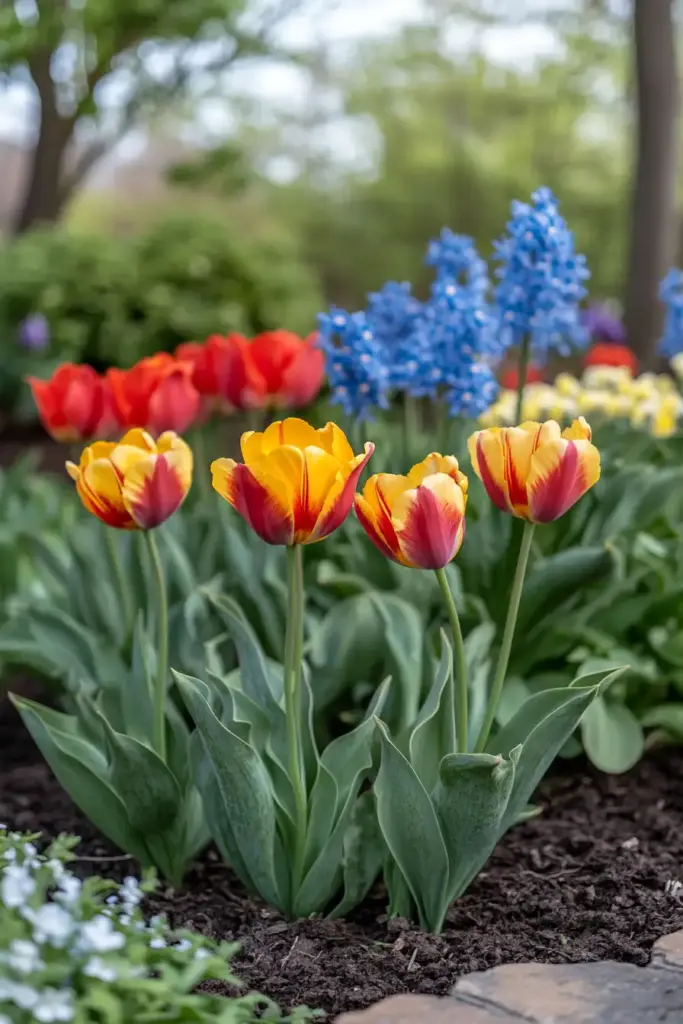Few flowers bring as much springtime cheer as tulips. These iconic blooms are among the first to emerge after winter, painting gardens with bold colors and a sense of renewal. Whether you’re a seasoned gardener or just starting out, planting and caring for tulips is a rewarding experience that can transform your outdoor space into a vibrant floral showcase.
In this guide, we’ll walk you through everything you need to know—from selecting the best varieties to planting tips, seasonal care, and even how to outsmart common pests. Let’s dig into how to grow tulips that thrive year after year.
🌿 Tulips 101: Get to Know These Springtime Showstoppers
Before diving into the details of planting and caring for tulips, it helps to understand what makes these flowers so beloved—and how diverse they really are.
🌍 A Quick History
Tulips may be a symbol of Dutch gardens today, but they actually trace their roots back to Central Asia and the Middle East. They’ve been cultivated for centuries, cherished for their elegant shape and brilliant hues. Today, over 3,000 varieties of tulips are recognized, falling into 15 groups based on features like petal shape, height, and bloom time.
🌸 Shapes, Colors, and Sizes
- Shapes: While most tulips are known for their cup-like blooms, some varieties are fringed, ruffled, star-shaped, or even lily-like.
- Colors: Available in nearly every shade of the rainbow—from deep purples to bright whites, soft pastels, and fiery reds.
- Height: Depending on the type, tulips can range from a petite 4 inches to an impressive 28 inches tall.
Keep in mind: Tulips generally bloom for about one to two weeks, but their impact in the garden is unforgettable when mass-planted or paired with early spring bulbs like crocuses or daffodils.
🌼 Are Tulips Perennials or Annuals? Here’s the Real Deal
Botanically speaking, tulips are perennials—meaning they’re capable of blooming year after year. But in practice? It’s a little more complicated.
🧬 Why Tulips Don’t Always Come Back
Modern tulips have been hybridized for beauty and bloom power, not necessarily for long-term resilience. Over time, many tulip bulbs lose vigor, especially in climates that differ from their native habitat (think dry summers and cold winters like those in Central Asia).
In most regions of North America, especially areas with humid summers and heavy soils, tulips perform best when treated as annuals. That means planting fresh bulbs each fall for a reliable spring show.
🌱 Perennial Performance: Where They Thrive
Tulips stand the best chance of reblooming in regions like:
- The western U.S. mountains, where soil is gritty and drainage is excellent
- Zones with cold winters and dry, warm summers
If you live outside these areas, don’t worry—tulip bulbs are affordable, easy to plant, and bloom spectacularly their first year. Think of them as one-season wonders that are totally worth the effort.
🌱 How to Plant Tulip Bulbs Like a Pro
Getting tulips off to a strong start begins with proper planting. Tulips aren’t fussy, but they do have a few specific needs to bloom their best.
❄️ Give Them a Chill
Tulips require a chilling period—a process known as vernalization—to trigger blooming. If you live in a region where winter temperatures consistently dip into the 30s (Fahrenheit), nature takes care of this for you.
Warm-climate gardeners (Zones 8–10): Buy pre-chilled bulbs, or store bulbs in the fridge (away from fruit) for 10–12 weeks before planting.
📅 When to Plant Tulip Bulbs
Timing is everything! Plant your tulips in the fall, ideally:
- 6 to 8 weeks before your area’s first hard frost
- September–October in cooler zones
- November–December in warmer southern zones
This timing allows bulbs to establish strong roots before winter sets in.
☀️ Where to Plant Tulips for the Best Blooms

Choosing the right spot is key to planting and caring for tulips successfully. These spring beauties need the proper mix of sunlight and soil to thrive.
🌞 Light Requirements
Tulips love the sun. For the best blooms, plant them in areas that get:
- Full sun (at least 6 hours a day)
- Or morning sun with afternoon shade in hotter climates (Zones 7–8)
In warm regions, too much heat can shorten the bloom period, so partial shade can actually help prolong their beauty.
🪨 Soil Needs
This part’s critical: Tulips hate wet feet. Poor drainage is the fastest way to rot your bulbs.
- Ideal soil: Loose, sandy, well-draining
- Avoid: Clay-heavy or soggy spots
- Fix it: Amend with compost or organic matter if your soil retains too much moisture
💡 Pro Tip: Plant in raised beds or containers if your garden has heavy soil. This gives you full control over drainage.
🌷 How Deep to Plant Tulip Bulbs (and How Far Apart)
Planting tulip bulbs at the right depth and spacing gives them the best chance to grow strong and healthy. Think of it as setting a solid foundation for your spring display.
📏 Planting Depth
Tulip bulbs should be planted 6 to 8 inches deep—measured from the top of the bulb to the soil surface.
- Pointy side up, flat side down
- Cover with soil and gently press to remove air pockets
This depth helps protect the bulbs from temperature swings, rot, and sneaky critters.
↔️ Spacing for Success
Give each bulb about 4 to 6 inches of space in all directions. This:
- Allows for air circulation
- Reduces the risk of fungal diseases
- Gives each tulip room to grow without competition
🌼 Planting Tip: For a naturalized look, scatter the bulbs randomly and plant where they land. For a more formal design, plant in rows or circular clusters.
🌾 Spacing & Fertilization: Fueling Healthy Tulip Growth

Once you’ve got your tulips tucked into the ground at the right depth, proper spacing and fertilization can make the difference between “meh” and magnificent blooms.
🪴 Why Spacing Matters (Again)
As a quick recap:
- Space bulbs 4 to 6 inches apart
- This prevents overcrowding and ensures each plant has access to light, nutrients, and airflow
- Good spacing also helps avoid moisture buildup around the leaves—a major cause of fungal diseases
💪 Feeding Your Tulips
Tulip bulbs are little powerhouses, storing all the nutrients they need to get started. But if you’re hoping for repeat blooms or want to support their strongest performance, a little boost helps.
Here’s how to fertilize tulips for long-term health:
- At planting time: Mix a bulb-specific fertilizer or bone meal into the soil at the bottom of the hole
- In early spring: Apply bulb food when you first see the shoots emerging
- After blooming (optional): Add compost to restore nutrients if you’re trying to naturalize or encourage perennial growth
⚠️ Avoid high-nitrogen fertilizers, which promote leafy growth at the expense of blooms.
🌼 How to Take Care of Tulips Through the Seasons
Once planted, tulips are surprisingly low-maintenance—but a little seasonal care can help them thrive and even return for another round of blooms.
💧 Watering Wisely
Tulip bulbs prefer drier conditions, especially after planting. Here’s the breakdown:
- After planting in fall: If you’re getting weekly rain, no need to water. In dry conditions, give them a light watering once a week until the first frost.
- During spring growth: Let nature handle it unless there’s a drought.
- After blooming: Stop watering altogether. Wet soil post-bloom can cause bulbs to rot.
🌧️ Pro Tip: Avoid using irrigation systems near tulip beds—these often keep the soil too moist.
🌱 Feeding During Growth
- Apply bulb food or bone meal in early spring, when leaves just begin to emerge.
- If you’re hoping your tulips rebloom next year, add a layer of compost after the flowers fade to replenish nutrients.
💤 Summer Dormancy Care
In warmer climates or areas without a proper winter chill, tulip bulbs may need extra TLC:
- Dig up the bulbs after the foliage dies down.
- Store in a cool, dry place all summer.
- Chill in the refrigerator (not freezer!) for 8–12 weeks before replanting in the fall.
Remember: Excess moisture is the enemy. Tulips are prone to rot if left in wet or poorly draining soils.
✂️ When to Cut Back Tulips (Without Ruining Next Year’s Blooms)
It’s tempting to tidy up your garden the moment tulips finish blooming—but when it comes to tulip care, patience pays off.
🟡 Let the Leaves Stay
After the flowers fade, the leaves should remain on the plant for at least 6 weeks. Why?
- The green foliage absorbs sunlight and converts it into energy
- That energy is stored in the bulb to fuel next year’s blooms
If you cut back too soon, the bulb won’t have the nutrients it needs to return.
🌱 What to do:
- Snip off the spent flower heads to prevent seed formation
- Let the leaves yellow and wither naturally before removing them
💡 Gardeners often plant tulips behind low-growing perennials or groundcovers to help disguise fading foliage.
🐛 Pests and Diseases That Affect Tulips (And How to Prevent Them)
Tulips are generally easy to grow, but like all garden plants, they can fall victim to a few pests and diseases—especially in wet or poorly drained conditions.
🦠 Common Tulip Diseases
Excess moisture is often the root of these issues. Here are a few to watch out for:
- Basal Rot: Caused by Fusarium oxysporum, this fungal infection shows as brown, mushy spots on the bulb or roots, often with a white or pink fungal coating. Infected bulbs may produce deformed flowers.
- Tulip Fire: Also known as Botrytis tulipae, this aggressive fungus causes twisted shoots, gray mold, and streaked blooms. It’s highly contagious—remove and destroy affected plants immediately.
- Black Rot: A soil-borne fungus that causes soft, rotting spots on bulbs and reddish, wilted foliage. Clean tools and avoid replanting in the same area.
🛡️ Prevention Tips:
- Always plant in well-draining soil
- Don’t overwater
- Rotate planting spots every few years
- Treat bulbs with a fungicide before planting if you’ve had issues in the past
🐞 Pesky Pests
- Aphids: Tiny sap-suckers that can spread viruses; spray with insecticidal soap if needed
- Slugs and Snails: Chew on foliage; use barriers or organic slug bait
- Nematodes: Microscopic pests that attack roots—buy certified pest-free bulbs to avoid them
- Squirrels, Deer, and Rodents: They love to dig up and snack on bulbs. Protect tulips by:
- Planting in wire bulb cages
- Using deterrents like blood meal or garlic spray
- Covering beds with mesh until bulbs establish
🧠 Pro Tip: Interplant tulips with daffodils—most critters avoid daffodil bulbs because they’re toxic.
🌷 Recommended Tulip Varieties: Annual & Perennial Picks
With over 3,000 cultivars to choose from, tulips come in nearly every shape, size, and color imaginable. Whether you’re planting for a one-season splash or hoping for years of spring color, there’s a tulip variety for you.
🌟 Best Annual Tulips (One-Season Wonders)
These varieties offer unforgettable color and form—even if just for a single spring:
- ‘Cracker Tulip’ – A rich violet-purple beauty that blooms mid-spring and grows to about 20 inches tall.
- ‘Ile de France’ – Bold, scarlet-red petals on 22-inch stems; perfect for a dramatic focal point.
- ‘Abu Hassan’ – Striking mahogany-red blooms with golden-orange edges—eye-catching and unique.
- ‘Calgary’ – A compact, crisp white tulip with blue-green foliage. Great for borders and containers.
- ‘Prinses Irene’ – Classic Rembrandt-style tulip with orange petals kissed with purple streaks.
🌿 Perennial Tulips (More Likely to Rebloom)
These tulips tend to perform better as long-term additions to the garden, especially in ideal conditions:
- Darwin Hybrids – Known for their large blooms and sturdy stems (up to 28 inches tall). Varieties like:
- ‘Acropolis’ (red-pink)
- ‘American Dream’ (golden-yellow with red)
- ‘Light and Dreamy’ (sugar pink with lavender)
- Botanical Tulips (Tulipa sylvestris) – Also called the Woodland or Florentine tulip, these heirlooms are small, hardy, and naturalize beautifully in the right setting.
- Clusiana Hybrids – Also known as Persian or Lady Tulips. Petite (4–8 inches), super tough, and ideal for dry spots or rock gardens.
🌼 Pro Tip: Mix early-, mid-, and late-season tulips for a prolonged bloom display!
🌸 Final Thoughts on Planting and Caring for Tulips
Planting and caring for tulips is one of the most rewarding ways to usher in spring. With their bold colors and graceful form, tulips add instant charm to any garden. Whether you’re tucking bulbs into a sunny border or creating a show-stopping container display, just remember:
- Plant in well-drained soil
- Time it right in fall
- Give bulbs the chill they need
- Avoid overwatering
- Let the foliage die back naturally
And if you’re feeling adventurous, experiment with varieties that can rebloom—or try mixing colors and shapes for a painterly effect.
With just a little prep, tulips can become the stars of your spring garden year after year.


